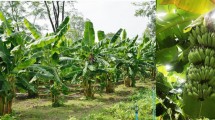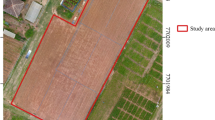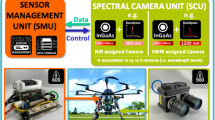Abstract
The objective of this study was to evaluate the crop monitoring performance of a consumer-grade camera with non-modified and modified spectral ranges which are commonly used in low-altitude unmanned aerial vehicle (UAV) platforms. The camera was fixed sequentially with seven types of filters for collecting visible images and near-infrared (NIR) images with different center band locations and bandwidths. Meanwhile, field-based hyperspectral data and normalized difference vegetation index (NDVI) measured by a GreenSeeker handheld crop sensor (GS-NDVI) were collected to examine the accuracy of rapeseed growth monitoring in terms of vegetation indices (VIs) derived from UAV images. Results showed that the UAV-based RGB-VIs and optimal NIR-VIs had similar accuracy for predicting GS-NDVI. Moreover, similar results were achieved based on the hyperspectral data, indicating the importance of spectral characteristics for GS-NDVI estimation. However, the UAV-based results also indicated that the performance of VIs derived from the band combinations containing longer NIR center wavelengths and narrower bandwidths was obviously poorer than that of the RGB-VIs. The image quality of the NIR band was also found to be inferior to the visible band based on quantitative analysis, which also revealed that image quality had great impact on UAV-based results. Image quality was then related to the effects of camera exposure, spectral sensitivity, soil background and dark areas. The results from this study provide useful information for camera modifications by selecting appropriate filters that not only are sensitive to crop growth, but also ensure image quality.














Similar content being viewed by others
References
Aasen, H., Burkart, A., Bolten, A., & Bareth, G. (2015). Generating 3D hyperspectral information with lightweight UAV snapshot cameras for vegetation monitoring: From camera calibration to quality assurance. ISPRS Journal of Photogrammetry and Remote Sensing, 108, 245–259. https://doi.org/10.1016/j.isprsjprs.2015.08.002.
Aasen, H., Honkavaara, E., Lucieer, A., & Zarco-Tejada, P. (2018). Quantitative remote sensing at ultra-high resolution with UAV spectroscopy: A review of sensor technology, measurement procedures, and data correction workflows. Remote Sensing, 10, 1091. https://doi.org/10.3390/rs10071091.
Anil, G. K., Vishal, B., Varinderpal, S., & Manjeet, S. (2016). Spectral analysis for monitoring crop growth using tractor mounted spectroradiometer and hand held GreenSeeker in cotton. Poljoprivredna Tehnika, 41, 21–30.
Bannari, A., Morin, D., Bonn, F., & Huete, A. R. (1995). A review of vegetation indices. Remote Sensing Reviews, 13, 95–120.
Bell, A. A., Seiler, C., Kaftan, J. N., & Aach, T. (2008) Noise in high dynamic range imaging In 2008 15th IEEE International Conference on Image Processing (pp. 561–564). Aachen, Germany. IEEE.
Bendig, J., Yu, K., Aasen, H., Bolten, A., Bennertz, S., Broscheit, J., et al. (2015). Combining UAV-based plant height from crop surface models, visible, and near infrared vegetation indices for biomass monitoring in barley. International Journal of Applied Earth Observation and Geoinformation, 39, 79–87.
Chan, J. C.-W., & Paelinckx, D. (2008). Evaluation of random forest and Adaboost tree-based ensemble classification and spectral band selection for ecotope mapping using airborne hyperspectral imagery. Remote Sensing of Environment, 112, 2999–3011.
Coburn, C. A., Smith, A. M., Logie, G. S., & Kennedy, P. (2018). Radiometric and spectral comparison of inexpensive camera systems used for remote sensing. International Journal of Remote Sensing, 39, 4869–4890. https://doi.org/10.1080/01431161.2018.1466085.
Deng, L., Mao, Z., Li, X., Hu, Z., Duan, F., & Yan, Y. (2018). UAV-based multispectral remote sensing for precision agriculture: a comparison between different cameras. ISPRS Journal of Photogrammetry and Remote Sensing, 146, 124–136. https://doi.org/10.1016/j.isprsjprs.2018.09.008.
Ding, Y., McCloskey, S., & Yu, J. (2010). Analysis of motion blur with a flutter shutter camera for non-linear motion. In European Conference on Computer Vision (pp. 15–30). Berlin, Heidelberg, Germany: Springer.
Elvidge, C. D., & Chen, Z. (1995). Comparison of broad-band and narrow-band red and near-infrared vegetation indices. Remote Sensing of Environment, 54, 38–48.
Haghighattalab, A., González Pérez, L., Mondal, S., Singh, D., Schinstock, D., & Rutkoski, J., et al. (2016). Application of unmanned aerial systems for high throughput phenotyping of large wheat breeding nurseries. Plant Methods, 12, 35. https://doi.org/10.1186/s13007-016-0134-6.
Hasinoff, S. W., Sharlet, D., Geiss, R., Adams, A., Barron, J. T., Kainz, F., et al. (2016). Burst photography for high dynamic range and low-light imaging on mobile cameras. ACM Transactions on Graphics, 35, 192.
Hollberg, J., & Schellberg, J. (2017). Distinguishing intensity levels of grassland fertilization using vegetation indices. Remote Sensing, 9, 81. https://doi.org/10.3390/rs9010081.
Hruska, R., Mitchell, J., Anderson, M., & Glenn, N. F. (2012). Radiometric and geometric analysis of hyperspectral imagery acquired from an unmanned aerial vehicle. Remote Sensing, 4, 2736–2752. https://doi.org/10.3390/rs4092736.
Hunt, E. R., Cavigelli, M., Daughtry, C. S. T., Mcmurtrey, J. E., & Walthall, C. L. (2005). Evaluation of digital photography from model aircraft for remote sensing of crop biomass and nitrogen status. Precision Agriculture, 6, 359–378. https://doi.org/10.1007/s11119-005-2324-5.
Inoue, Y., Sakaiya, E., Zhu, Y., & Takahashi, W. (2012). Diagnostic mapping of canopy nitrogen content in rice based on hyperspectral measurements. Remote Sensing of Environment, 126, 210–221.
Jay, S., Baret, F., Dutartre, D., Malatesta, G., Héno, S., Comar, A., et al. (2018). Exploiting the centimeter resolution of UAV multispectral imagery to improve remote-sensing estimates of canopy structure and biochemistry in sugar beet crops. Remote Sensing of Environment, 231, 110898. https://doi.org/10.1016/j.rse.2018.09.011.
Jay, S., Gorretta, N., Morel, J., Maupas, F., Bendoula, R., Rabatel, G., et al. (2017). Estimating leaf chlorophyll content in sugar beet canopies using millimeter- to centimeter-scale reflectance imagery. Remote Sensing of Environment, 198, 173–186. https://doi.org/10.1016/j.rse.2017.06.008.
Jonckheere, I., Fleck, S., Nackaerts, K., Muys, B., Coppin, P., Weiss, M., et al. (2004). Review of methods for in situ leaf area index determination. Agricultural and Forest Meteorology, 121, 19–35. https://doi.org/10.1016/j.agrformet.2003.08.027.
Jongschaap, R. E., & Booij, R. (2004). Spectral measurements at different spatial scales in potato: Relating leaf, plant and canopy nitrogen status. International Journal of Applied Earth Observation and Geoinformation, 5, 205–218.
Jordan, C. F. (1969). Derivation of leaf-area index from quality of light on the forest floor. Ecology, 50, 663–666.
Kim, D. W., Yun, H., Jeong, S. J., Kwon, Y. S., Kim, S. G., Lee, W., et al. (2018). Modeling and testing of growth status for Chinese cabbage and white radish with UAV-based RGB imagery. Remote Sensing, 10, 563.
Le Maire, G., François, C., Soudani, K., Berveiller, D., Pontailler, J.-Y., Bréda, N., et al. (2008). Calibration and validation of hyperspectral indices for the estimation of broadleaved forest leaf chlorophyll content, leaf mass per area, leaf area index and leaf canopy biomass. Remote Sensing of Environment, 112, 3846–3864.
Li, H., Liu, W., Dong, B., Kaluzny, J. V., Fawzi, A. A., & Zhang, H. F. (2017). Snapshot hyperspectral retinal imaging using compact spectral resolving detector array. Journal of Biophotonics, 10, 830–839. https://doi.org/10.1002/jbio.201600053.
Li, J., Shi, Y., Veeranampalayam-Sivakumar, A.-N., & Schachtman, D. P. (2018). Elucidating sorghum biomass, nitrogen and chlorophyll contents with spectral and morphological traits derived from unmanned aircraft system. Frontiers in Plant Science, 9, 1406. https://doi.org/10.3389/fpls.2018.01406.
Liu, K., Zhou, Q., Wu, W., Xia, T., & Tang, H. (2016). Estimating the crop leaf area index using hyperspectral remote sensing. Journal of Integrative Agriculture, 15, 475–491. https://doi.org/10.1016/S2095-3119(15)61073-5.
Liu, S., Li, L., Gao, W., Zhang, Y., Liu, Y., Wang, S., et al. (2018). Diagnosis of nitrogen status in winter oilseed rape (Brassica napus L.) using in-situ hyperspectral data and unmanned aerial vehicle (UAV) multispectral images. Computers and Electronics in Agriculture, 151, 185–195. https://doi.org/10.1016/j.compag.2018.05.026.
Lu, B., & He, Y. (2017). Species classification using unmanned aerial vehicle (UAV)-acquired high spatial resolution imagery in a heterogeneous grassland. ISPRS Journal of Photogrammetry and Remote Sensing, 128, 73–85. https://doi.org/10.1016/j.isprsjprs.2017.03.011.
Lu, D. (2006). The potential and challenge of remote sensing-based biomass estimation. International Journal of Remote Sensing, 27, 1297–1328. https://doi.org/10.1080/01431160500486732.
Lussem, U., Hollberg, J., Menne, J., Schellberg, J., & Bareth, G. (2017). Using calibrated RGB imagery from low-cost UAVs for grassland monitoring: Case study at the Rengen Grassland Experiment (RGE), Germany. The International Archives of Photogrammetry, Remote Sensing and Spatial Information Sciences, 2, 229–233. https://doi.org/10.5194/isprs-archives-XLII-2-W6-229-2017.
Mandal, U. K., Singh, G., Victor, U. S., & Sharma, K. L. (2003). Green manuring: Its effect on soil properties and crop growth under rice-wheat cropping system. European Journal of Agronomy, 19, 225–237.
Marshall, M., & Thenkabail, P. (2015). Developing in situ non-destructive estimates of crop biomass to address issues of scale in remote sensing. Remote Sensing, 7, 808–835. https://doi.org/10.3390/rs70100808.
Meyer, G. E., Hindman, T. W., & Laksmi, K. (1999). Machine vision detection parameters for plant species identification. In Precision Agriculture and Biological Quality (pp. 327–335). Boston, USA: International Society for Optics and Photonics.
Meyer, G. E., & Neto, J. C. (2008). Verification of color vegetation indices for automated crop imaging applications. Computers and electronics in agriculture, 63, 282–293.
Monno, Y., Teranaka, H., Yoshizaki, K., Tanaka, M., & Okutomi, M. (2019). Single-sensor RGB-NIR imaging: High-quality system design and prototype implementation. IEEE Sensors Journal, 19, 497–507.
Nijland, W., de Jong, R., de Jong, S. M., Wulder, M. A., Bater, C. W., & Coops, N. C. (2014). Monitoring plant condition and phenology using infrared sensitive consumer grade digital cameras. Agricultural and Forest Meteorology, 184, 98–106. https://doi.org/10.1016/j.agrformet.2013.09.007.
Pradhan, S., Sehgal, V. K., Bandyopadhyay, K. K., Sahoo, R. N., Panigrahi, P., Parihar, C. M., et al. (2018). Comparison of vegetation indices from two ground based sensors. Journal of the Indian Society of Remote Sensing, 46, 321–326. https://doi.org/10.1007/s12524-017-0671-0.
Richardson, A. J., & Everitt, J. H. (1992). Using spectral vegetation indices to estimate rangeland productivity. Geocarto International, 7, 63–69.
Rondeaux, G., Steven, M., & Baret, F. (1996). Optimization of soil-adjusted vegetation indices. Remote Sensing of Environment, 55, 95–107.
Roth, L., & Streit, B. (2018). Predicting cover crop biomass by lightweight UAS-based RGB and NIR photography: An applied photogrammetric approach. Precision Agriculture, 19, 93–114. https://doi.org/10.1007/s11119-017-9501-1.
Roujean, J.-L., & Breon, F.-M. (1995). Estimating PAR absorbed by vegetation from bidirectional reflectance measurements. Remote Sensing of Environment, 51, 375–384.
Rouse, J., Jr., Haas, R. H., Schell, J. A., & Deering, D. W. (1974). Monitoring vegetation systems in the great plains with ERTS. NASA Special Publication, 351, 309–317.
Singh, I., Srivastava, A. K., Chandna, P., & Gupta, R. K. (2006). Crop sensors for efficient nitrogen management in sugarcane: Potential and constraints. Sugar Tech, 8, 299–302.
Singh, N., Kumar, M., Pj, M., Sarkar, R. (2018) Depth aware portrait segmentation using dual focus images. In 2018 IEEE International Conference on Multimedia and Expo (pp. 1–6). San Diego, USA. IEEE.
Teal, R. K., Tubana, B., Girma, K., Freeman, K. W., Arnall, D. B., Walsh, O., et al. (2006). In-season prediction of corn grain yield potential using normalized difference vegetation index. Agronomy Journal, 98, 1488–1494.
Thenkabail, P. S., Smith, R. B., & De Pauw, E. (2000). Hyperspectral vegetation indices and their relationships with agricultural crop characteristics. Remote Sensing of Environment, 71, 158–182. https://doi.org/10.1016/S0034-4257(99)00067-X.
Thenkabail, P. S., Smith, R. B., & De Pauw, E. (2002). Evaluation of narrowband and broadband vegetation indices for determining optimal hyperspectral wavebands for agricultural crop characterization. Photogrammetric Engineering and Remote Sensing, 68, 607–622.
Uddling, J., Gelang-Alfredsson, J., Piikki, K., & Pleijel, H. (2007). Evaluating the relationship between leaf chlorophyll concentration and SPAD-502 chlorophyll meter readings. Photosynthesis Research, 91, 37–46. https://doi.org/10.1007/s11120-006-9077-5.
Vriet, C., Russinova, E., & Reuzeau, C. (2012). Boosting crop yields with plant steroids. The Plant Cell, 24, 842–857. https://doi.org/10.1105/tpc.111.094912.
Widjaja Putra, B. T., & Soni, P. (2017). Evaluating NIR-Red and NIR-Red edge external filters with digital cameras for assessing vegetation indices under different illumination. Infrared Physics & Technology, 81, 148–156. https://doi.org/10.1016/j.infrared.2017.01.007.
Woebbecke, D. M., Meyer, G. E., Von Bargen, K., & Mortensen, D. A. (1995). Color indices for weed identification under various soil, residue, and lighting conditions. Transactions of the ASAE, 38, 259–269.
Wu, B., Meng, J., Li, Q., Yan, N., Du, X., & Zhang, M. (2014). Remote sensing-based global crop monitoring: Experiences with China’s CropWatch system. International Journal of Digital Earth, 7, 113–137. https://doi.org/10.1080/17538947.2013.821185.
Wu, M., Yang, C., Song, X., Hoffmann, W., Huang, W., Niu, Z., et al. (2017). Evaluation of orthomosics and digital surface models derived from aerial imagery for crop type mapping. Remote Sensing, 9, 239. https://doi.org/10.3390/rs9030239.
Yang, C., Westbrook, J., Suh, C., Martin, D., Hoffmann, W., Lan, Y., et al. (2014). An airborne multispectral imaging system based on two consumer-grade cameras for agricultural remote sensing. Remote Sensing, 6, 5257–5278. https://doi.org/10.3390/rs6065257.
Yao, X., Zhu, Y., Tian, Y., Feng, W., & Cao, W. (2010). Exploring hyperspectral bands and estimation indices for leaf nitrogen accumulation in wheat. International Journal of Applied Earth Observation and Geoinformation, 12, 89–100.
Yao, X., Wang, N., Liu, Y., Cheng, T., Tian, Y., Chen, Q., et al. (2017). Estimation of wheat LAI at middle to high levels using unmanned aerial vehicle narrowband multispectral imagery. Remote Sensing, 9, 1304. https://doi.org/10.3390/rs9121304.
Yao, Y., Miao, Y., Huang, S., Gao, L., Ma, X., Zhao, G., et al. (2012). Active canopy sensor-based precision N management strategy for rice. Agronomy for Sustainable Development, 32, 925–933.
Yu, K., Lenz-Wiedemann, V., Chen, X., & Bareth, G. (2014). Estimating leaf chlorophyll of barley at different growth stages using spectral indices to reduce soil background and canopy structure effects. ISPRS Journal of Photogrammetry and Remote Sensing, 97, 58–77. https://doi.org/10.1016/j.isprsjprs.2014.08.005.
Zaman-Allah, M., Vergara, O., Araus, J. L., Tarekegne, A., Magorokosho, C., Zarco-Tejada, P. J., et al. (2015). Unmanned aerial platform-based multi-spectral imaging for field phenotyping of maize. Plant Methods, 11, 35. https://doi.org/10.1186/s13007-015-0078-2.
Zarco-Tejada, P., Berjon, A., Lopezlozano, R., Miller, J., Martin, P., Cachorro, V., et al. (2005). Assessing vineyard condition with hyperspectral indices: Leaf and canopy reflectance simulation in a row-structured discontinuous canopy. Remote Sensing of Environment, 99, 271–287. https://doi.org/10.1016/j.rse.2005.09.002.
Zarco-Tejada, P., Miller, J., Morales, A., Berjón, A., & Agüera, J. (2004). Hyperspectral indices and model simulation for chlorophyll estimation in open-canopy tree crops. Remote Sensing of Environment, 90, 463–476. https://doi.org/10.1016/j.rse.2004.01.017.
Zhang, C., & Kovacs, J. M. (2012). The application of small unmanned aerial systems for precision agriculture: A review. Precision Agriculture, 13, 693–712. https://doi.org/10.1007/s11119-012-9274-5.
Zhang, J., Yang, C., Zhao, B., Song, H., Clint Hoffmann, W., Shi, Y., et al. (2017). Crop classification and LAI estimation using original and resolution-reduced images from two consumer-grade cameras. Remote Sensing, 9, 1054. https://doi.org/10.3390/rs9101054.
Zhang, Y., Chen, J. M., & Miller, J. R. (2005). Determining digital hemispherical photograph exposure for leaf area index estimation. Agricultural and Forest Meteorology, 133, 166–181. https://doi.org/10.1016/j.agrformet.2005.09.009.
Zhao, D., Huang, L., Li, J., & Qi, J. (2007). A comparative analysis of broadband and narrowband derived vegetation indices in predicting LAI and CCD of a cotton canopy. ISPRS Journal of Photogrammetry and Remote Sensing, 62, 25–33.
Zhou, X., Zheng, H. B., Xu, X. Q., He, J. Y., Ge, X. K., Yao, X., et al. (2017). Predicting grain yield in rice using multi-temporal vegetation indices from UAV-based multispectral and digital imagery. ISPRS Journal of Photogrammetry and Remote Sensing, 130, 246–255. https://doi.org/10.1016/j.isprsjprs.2017.05.003.
Acknowledgements
This work was financially supported by the National Key Research and Development Program of China (2018YFD1000901) and the Fundamental Research Funds for the Central Universities (Grant Nos. 2662018PY101 and 2662018JC012). Special thanks go to the field staff of Huazhong Agricultural University for their daily management of the field experiments. We are grateful to the reviewers for their valuable comments and recommendations.
Author information
Authors and Affiliations
Corresponding authors
Additional information
Publisher's Note
Springer Nature remains neutral with regard to jurisdictional claims in published maps and institutional affiliations.
Rights and permissions
About this article
Cite this article
Zhang, J., Wang, C., Yang, C. et al. Evaluation of a UAV-mounted consumer grade camera with different spectral modifications and two handheld spectral sensors for rapeseed growth monitoring: performance and influencing factors. Precision Agric 21, 1092–1120 (2020). https://doi.org/10.1007/s11119-020-09710-w
Published:
Issue Date:
DOI: https://doi.org/10.1007/s11119-020-09710-w




